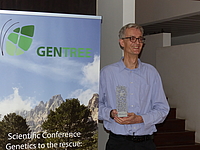
Forests face great challenges from climate change, including incidence of pests and diseases. Foresters and others want to understand how tree populations will respond. Will they adapt? Or will they vanish? Reforestation is no longer simple either, because climate change is also upsetting the - notion that “local is best” as a source of forest reproductive material. If not locally, though, where should seeds for planting come from?
While there are no simple answers to any of these vitally important questions, it is clear that genomic studies have the potential to lead to greater understanding and flourishing forests.
Last year, a conference on Genomics and Forest Tree Genetics, organised by IUFRO, brought researchers together to discuss the state of forest tree genomics, how that informs the current understanding of evolutionary processes, and to consider how recent research can enhance conservation and sustainable use. A recently published paper by some of the conference participants summarized the presentations.
Genomics
Sequencing tree genomes got off to a slow start but is now accelerating, with many economically and ecologically important tree species in the pipeline. One emerging aspect of interest is that even quite unrelated species often share the order of their genes on the chromosomes. This phenomenon, known as synteny, is also well known in crop plants; if anything, trees manifest synteny more strongly than crops, which hints that in trees there may be more active selection to preserve the underlying organisation of the genome (although not the sequence itself) than in herbaceous annuals.
One of the most important uses of genetic data is to investigate the history of tree evolution and to find out how different species are related. This is important because it can offer insights into the processes that result in speciation. For example, one study of the Asian genus Castanopsis dates major speciation to the late Miocene era and links it to the uplift of the Himalayas.
Adaptation
Looking closely at how past climate is related to both the distribution and the genetic variation of different species is beginning to shed light on how present tree populations might be affected by climatic change. Two different studies, one of mountain hemlock (Tsuga mertensiana) and one of Sitka spruce (Picea sitchensis), showed that recently-established populations contain high levels of genetic variation. This would not be expected if a new population was established by a few founders and then genetically isolated. For the two species, the landscape allows populations to connect; long distance dispersal of pollen and seed provides the genetic diversity that is an essential raw material as populations adapt to new environments.
Adaptation generally reflects many different kinds of environmental variation, for example in physical parameters such as photoperiod, water availability, temperature regimes and soil type as well as biological factors such as pests and diseases. Earlier studies have suggested that the importance of adapting to photoperiod and temperature across a wide range of latitudes and altitudes – so that the tree maximizes growth while minimising the risk of frost damage – might constrain the ability to adapt to novel climates. However, the meeting heard about a study of sessile oak (Quercus petrarea) that showed very little correlation between adaptation to photoperiod and adaptation to temperature. This suggests that adaptability to future climate change might be less constrained than previously believed.
Pests and diseases that expand into new areas and new hosts under climate change present a different kind of problem, which may in some cases be easier to solve. For example, a single gene enables white spruce (Picea glauca) to resist spruce budworm (Choristoneura spp.). It ought thus to be possible to screen forest reproductive material to ensure that it is carrying the resistance gene.
Conservation
The conference organisers were well aware of the practical importance of genetic information. The authors of the summary paper write: “Genomics has the potential to inform both forest conservation and tree breeding by providing greater knowledge of fine scale adaptation, allelic effects, and demographic processes.” That said, however, they also acknowledge that “building strategies that consider both genetic conservation and sustainable use remain largely anecdotal. The conference was a unique occasion to discover this little travelled road.”
As yet there is little concrete to show, but several promising possibilities. For example, ash trees (Fraxinus spp.) are threatened by ash die back (Hymenoscyphus fraxineus) in the UK and the emerald ash borer (Agrilus planipennis) in North America. Resistance to both seems to occur simultaneously in different branches of the ash evolutionary tree. A deeper understanding might help breeders to identify genes that could, through selective breeding, allow ash to continue to embellish our forests.
Looking forward
One of the primary aims of the conference was to share widely the current state of research on forest tree genomics; its success in that regard will be manifest in the future research results. But there is also a very practical side to the work. As Santiago. C. González- Martínez at INRA in France, one of the conference organisers, explained, knowledge of tree genomes offers society two clear benefits:
“On one side, identifying genetic variation – that is, specific alleles – that could be relevant for local adaptation and, thus, for forest survival and health. And on the other side, to accelerate breeding, allowing increased productivity and access to new forest products.”

